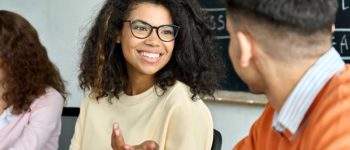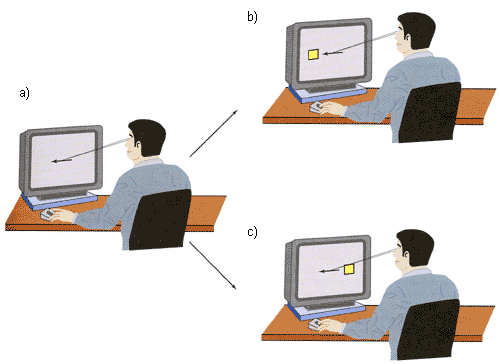What are selective attention, confusional state and undercover orientation?

- 4905
- 1511
- Jeffery Jones
Attention is a basic cognitive process. That is, an adequate care state is needed so that the rest of cognitive processes work correctly. The perception of internal and external stimuli that reach our brain depends on our attention state. Likewise, attention allows us to select the most important stimuli among the set of signals it receives Our brain, so that our behavior is correctly oriented towards the most relevant events of the environment that surrounds us.
Content
Toggle- Attention is a complex cognitive function
- The General Attention State
- Most frequent etiologies of the confusional state
- Selective attention
- Selective attention and covert orientation
Attention is a complex cognitive function
Attention is divided into the general care state and selective attention.
- The General Attention State refers to the ability to maintain in time an adequate state of alert that allows the correct processing of the stimuli of our environment.
- Selective attention It refers to the ability to select a discreet stimulus between the set of information that constantly comes to us, so we maximize the effectiveness of our cognitive resources and do not have to divide them among several sources of stimulation.
The General Attention State
The general care state is necessary to carry out any other cognitive function, since allows us to detect the inner and outer environment stimuli that surrounds us. When the general attention state is altered, all cognitive processes are affected.
The alteration of the general care state is known by the name of Confusional state.
The confusional state can be a consequence of metabolic alterations, poisoning or primary alterations of the central nervous system. Below are the most frequent causes of alteration of the general care state.
Most frequent etiologies of the confusional state
- Metabolic alterations: hypoxia; hypoglycemia; electrolytic imbalance; liver, renal or pulmonary alterations; endocrine alterations.
- Infections:
- Systemic: Pneumonia, septicemia.
- Intracranial: Meningitis, encephalitis.
- Poisoning: Alcohol; anticholinergic drugs; sedatives and hypnotics; Industrial toxic.
- Drug abstinence: Alcohol; sedatives and hypnotics.
- Neurological diseases: Epileptic crisis; Craneoecephalic trauma; Focal lesions (right parietal lobe, occipitotemporal region, frontal lobe, mesencephalon, thalamus).
- Others: Post -surgical states.
The patient in a confusional state is often sleepy and, in extreme cases, The confusional state can lead to coma. In any case, it seems that the confusional state does not necessarily coincide with an alteration of the general state of cortical activation (or arousal), since the alteration of attention can be much more serious than the state of drowsiness. Some patients, for example, They can be completely awake, even agitated, but showed a disproportionate alteration of attention. Thus, the mechanisms of general attention and those of the arousal do not seem to be completely overwhelmed.
In addition to the alteration of general care, the confusional state is characterized by the alteration of the state of surveillance and a high distractibility, which prevents maintaining a coherent and unable thought to carry out intentional movements. All cognitive functions (guidance, memory, language, judgment, etc.) They are altered. In the same way, perceptual alterations, such as hallucinations, mood alterations and pictures of psychomotor or extreme passivity can appear.
 Cherry selective care experiment
Cherry selective care experiment Selective attention
Of the set of stimuli that we constantly receive, we have to select one or more on which to focus our attention. This is achieved by selective care.
Imagine that you are at a party with many people talking around you. Assuming that your general attention status is correct, that is, assuming that you have not exceeded the consumption of alcoholic beverages, you will be able to detect many conversations. Selective attention will allow you to focus on one of these conversations and ignore the rest, so that they do not interfere with you.
But why do we need to focus our attention on a limited number of stimuli instead of processing them all? Perhaps our brain cannot process all sensory information simultaneously. However, although our brain could process all the sensory information simultaneously, The effectiveness of cognitive processing is greater when it is limited to a small number of stimuli.
Selective attention is a dynamic function, since we can change the focus of attention depending on the circumstances. Continuing with the example of the party, this allows, for example, that we quickly pay attention to the rear conversation if we feel someone talk about us. Sometimes, we will try to keep two or more focus of attention at the same time. We call this process divided attention. Logically, cognitive processing is less effective when we pay attention to many stimuli, since it increases the possibility of interference, but divided attention allows us to do several tasks at the same time, such as driving and maintaining a conversation, or cooking and listening to the news.

Selective attention and covert orientation
When we listen to an intense and sudden noise, we orient our senses towards the source of stimulation. Thus, for example, we turn the head and body, and move our eyes in the stimulus direction. This is one open guidance response, since it implies an obvious movement of different organs of the body.
Sometimes, however, we can focus on a stimulus without the need to perform any motor response types. This is called covert orientation.
Generally, undercover orientation accompanies the open orientation, but in experimental designs often covert orientation to study the neural bases of selective care has been used.
In a typical experimental situation, a subject is put in front of a computer screen and is asked to press a button as quickly as possible when detecting the presence of a specific stimulus (for example, a square) on either side of the two sides of the screen. The subject, however, is asked not to take the view of a point located in the middle of the screen. If before the appearance of the stimulus that must be detected we provide a track on the side where the stimulus will appear (for example, indicating with an arrow), the subject will detect more quickly the stimulus when the next one appears indicated by the arrow that when it appears The opposite side. This indicates that the subject, induced by the orientation of the arrow, had focused his attention to the side of the screen, although the eyes have not moved from the point located in the middle of the screen.

The subject has been instructed so as not to look away from the center of the screen and to press a button when detecting the presence of a square. If before the presentation of the stimulus we give a track on the side on which the square will appear, it will detect its presence more quickly when it appears together indicated by the arrow (b) that when the opposite side appears (c). This shows that, although he has not moved the eyes of the center of the screen, he had focused his attention next to the screen indicated by the arrow.
In the same way that we can focus attention on a specific spatial location, as in the previous example, we can also focus on a specific stimulus.
Cover orientation can be directed to both spatial locations and discrete stimuli.
This ability to focus our attention to discrete stimuli allows us to follow a stimulus in motion without moving our eyes. The fact that we focus our attention on a stimulus and not on the other depends on several factors, such as the physical characteristics of the stimulus (color, luminosity, etc.), if suddenly appears, if it moves or is static, it depends on the subjective relevance you have for us, etc.
Imagine that we present two stimuli in the same spatial location (for example, a square with a vertical line that crosses it from top to bottom) for a period of milliseconds time, which prevents ocular movements (taquitoscopic presentation). In this situation, the subjects can describe up to two characteristics of the same object (the square is red with the black contour, or the line is fine and has dots, for example), but they cannot describe a characteristic of each of the two objects (The square is red and the line is fine, for example). The reason is that your attention can only focus on one of the two objects.
- « 75 phrases of heartbreak and disappointment for people with a broken heart
- The health benefits of Rhodiola Rosea »

